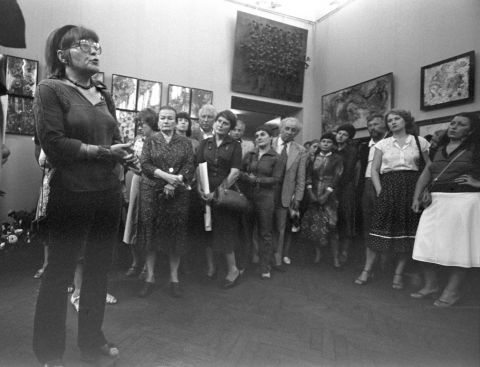ANATOLY GITBERG: THE HAPPY FATE OF AN ARTIST
When Anatoly Gitberg worked, he was always full of joy. And he worked non-stop – drawing, painting, modelling, designing, fantasizing. Heaps of drawing paper were lying all around, finely sharpened pencils stuck out like lances – there was always a sea of pencils around Gitberg; hardboard panels galore stood here and there, primed, gessoed and framed. He would select one or pick up what was near at hand and start working. He used to draw on special notepads, sitting in Council meetings and at a feast table. He always did that with pleasure, as if skipping the agonizing phase of creativity, bypassing it or doing without.
Anatoly Gitberg matured as an artist very early and in one go: the Gitberg phenomenon consists in that creative work was always joy, pleasure and happiness to him but never ordeal, suffering, despair or dashed dreams. He was a success in everything: his every intention and any experiment, the most daring ones, there and then transformed into hardboard panels, sheets, cutting boards or spaces. He always knew that he would do whatever he wished, the way he wished it and would be a success.
...And, of course, he had a stunning, unheard-of and incredible capacity for work.
Work came to Anatoly Gitberg as naturally as breathing and living. The Gitberg phenomenon was that there was complete mutual understanding between the man and the artist. The man was open-minded, generous and full of zest. Love and kindness to everyone and everything around was his way and philosophy of life.
Never alone, inseparable from his family, Mila, daughters, Arto the poodle, always in the company of friends, and not necessarily artists: physicists, actors and architects, they all got together at his place and chummed up with one another under the care of their large-hearted host. And not only friends for that matter, but simply acquaintances and even strangers (his was an open house) soon became no strangers, friends and regulars at his place and studio.
Always a good mixer, well-wishing and surprisingly convinced that whoever entered his place was worth his time and thought – that was the way Gitberg was.
He always had time and thought for everyone. Somehow, he managed to embrace all and everybody.
Irina Lavrova
Irina Igorevna Lavrova (1931–1999) – painter, member of the Union
of Artists of the USSR. She created paintings and sculptural reliefs in
architecture, most often worked in co-authorship with Igor Ptchelnikov.

